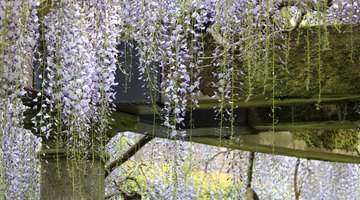How to Build a Wisteria Arbor
Table of Contents
A wisteria arbor adds a romantic touch to your backyard. Fragrant flower panicles hang from vines that drape the arbor and shade the requisite bench below. Building a wisteria arbor combines beauty and functionality to provide a respite from the summer sun or a contemplative retreat in your garden.

Because wisteria vines typically are vigorous and long-lived, it's important to build a sound structure that supports their growth.
Design Specifications and Site Selection
An arbor is composed of four vertical posts that support horizontal beams overhead. Two opposing sides of the arbor may be finished with latticework, leaving the other two sides open. Unlike a pergola, which is built over a walkway, an arbor is built over a bench. Before you begin building an arbor, choose a site that provides a focal point in your garden without overwhelming its overall design. Wisteria vines flower best in full sun, so select a sunny spot so you can enjoy an abundance of blooms.
A Firm Foundation
Don’t skimp on the materials or the construction of the foundation posts. Choose lumber that resists decay, such as redwood, cedar or pressure-treated wood. The four foundation posts should be 12 feet long and either 4 inches or 6 inches square. Using a posthole digger or 12-inch power auger, dig the post holes 54 to 60 inches, particularly in cold climates, so the completed arbor does not heave when the ground freezes and thaws. This depth also helps ensure that the heavy wisteria vines do not topple the structure. Lay a concrete footing pad or 4 to 6 inches of pea gravel in the bottom of each hole. Backfill each hole with Class 5 fill gravel, a few inches at a time, using a level after each addition to make sure each post stays plumb.
Overhead Assembly
Using carriage bolts, attach four horizontal two-by-six or two-by-eight support beams around the outside of the vertical posts near the top of the structure. Across the top of the arbor, screw two-by-six or two-by-eight boards onto the support beams. Space the boards depending on how much sun or shade you prefer, remembering that wisteria vines are deciduous. This means the vines provide shade underneath the arbor in spring and summer, but when the leaves fall in autumn, sunlight can reach the bench below. You can attach latticework to opposite sides of the arbor, or simply allow the wisteria vines to climb up the four foundation posts.
Plant Selection
Wisteria (Wisteria spp.) is a twining vine, which means its stems wrap around structures as it climbs. Asian species, such as Chinese wisteria (Wisteria sinensis), which grows in U.S. Department of Agriculture plant hardiness zones 3 through 9, and Japanese wisteria (Wisteria floribunda), which grows in USDA zones 5 through 8, typically have more aggressive growth and are commonly invasive. Native American wisteria (Wisteria frutescens), which is a perennial in USDA zones 5 through 9, is more restrained, less vigorous and more manageable. Likely, you're building a wisteria arbor to enjoy the breathtaking floral display in spring to early summer, but you may have to wait 10 to 15 years for an Asian variety to bloom. “Amethyst Falls” is an improved cultivar of American wisteria that has another benefit over its Asian cousins: It begins blooming when it’s only a year old.
Growth Habit
Although your arbor has four posts, don't plant a wisteria vine at each post or the plants will overpower the structure. Wisteria is a vigorous vine, so plant only one on each side of the arbor, either at the base of a post or in the middle of the two side posts. As the plants grow, their stems reach up and out until they find something to climb on, and they naturally begin to twine around the posts. Space each plant 12 inches from the post to give the trunk plenty of room to grow.
The Drip Cap
- A wisteria arbor adds a romantic touch to your backyard.
- Building a wisteria arbor combines beauty and functionality to provide a respite from the summer sun or a contemplative retreat in your garden.
- Unlike a pergola, which is built over a walkway, an arbor is built over a bench.
- Using a posthole digger or 12-inch power auger, dig the post holes 54 to 60 inches, particularly in cold climates, so the completed arbor does not heave when the ground freezes and thaws.
- This means the vines provide shade underneath the arbor in spring and summer, but when the leaves fall in autumn, sunlight can reach the bench below.
- Asian species, such as Chinese wisteria (Wisteria sinensis), which grows in U.S.
- Department of Agriculture plant hardiness zones 3 through 9, and Japanese wisteria (Wisteria floribunda), which grows in USDA zones 5 through 8, typically have more aggressive growth and are commonly invasive.
- Likely, you're building a wisteria arbor to enjoy the breathtaking floral display in spring to early summer, but you may have to wait 10 to 15 years for an Asian variety to bloom.
- “
References
Writer Bio
Victoria Lee Blackstone is a horticulturist and a professional writer who has authored research-based scientific/technical papers, horticultural articles, and magazine and newspaper articles. After studying botany and microbiology at Clemson University, Blackstone was hired as a University of Georgia Master Gardener Coordinator. She is also a former mortgage acquisition specialist for Freddie Mac in Atlanta, GA.
Photo Credits
- mtreasure/iStock/Getty Images
- mtreasure/iStock/Getty Images
More Articles


